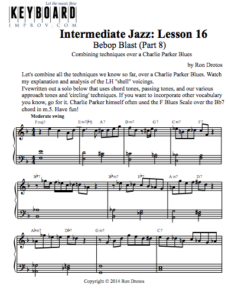
Bebop piano is a wonderful style to play, but even within the world of jazz it can be challenging. But you can learn how to play it, if you do it the right way and stay persistent! Here are 10 ways to get you started:
1. Listen to bebop recordings. I remember reading an interview with Joe Zawinul from Weather Report. He was saying how much he had learned from listening to recordings when he was first starting out. What impressed me the most was that he said how listing is so much fun that we don’t realizing how much we learn at the time. This is especially true with a style like bebop, which is so technically-specific. Listen to Bud Powell, Al Haig, and the other famous beboppers, but also be sure to check out lesser-known pianists such as Walter Bishop Jr. and Duke Jordan. And of course, absorb the sounds of sax players like Charlie Parker and trumpeter Dizzy Gillespie. Immerse yourself in their sounds.
2. Watch videos. There’s a visual component to learning jazz that’s often overlooked. We pick up a lot by simply looking at accomplished players playing the way we want to play ourselves. Luckily for us, there are videos of the great bebop musicians. There’s even a TV appearance of Charlie Parker himself, from the 1940’s! Go to YouTube and watch Bud Powell, Dizzy Gillespie and their compatriots in action. The importance of this cannot be overstated.
3. Learn bebop melodies. When I was a teenager, my piano teacher Billy Taylor, who had played with Charlie Parker and the other bebop greats, told me to study how bebop melodies are constructed. He observed that the same bebop language that we use to improvise is right there, in the melodies. Learn a few melodies, such as “Confirmation,” “Blues For Alice,” and “Yardbird Suite,” and then begin to improvise in a similar style.
4. Play transcriptions: Playing transcribed solos is a great way to get the bebop “feel” under your fingers. Start with the Charlie Parker Omnibook.
5. Sing along with bebop recordings. Put on a bebop recording such as “Moose The Mooche” and sing along. Just use nonsense syllables and have fun. Sing along with the melodies and solos until you gradually remember how they go. This will help you internalize the bebop language in a deep way!
6. Transcribe solos yourself. Transcribing solos is difficult at first, but it’s the way almost every major jazz musician has learned at some point in their development. It provides invaluable ear training and will bring you very close to the music itself.
7. Play along with recordings. Pretend you’re the second pianist in Charlie Parker’s group. Or put on a Sonny Rollins’ “A Night At The Village Vanguard” recording, which doesn’t have a pianist, and play chords behind Sonny! This will also give you a list of tunes to learn!
8. Learn from a teacher. At some point, you’ll probably want to study with an experienced jazz pianist. Whether you find someone local, or study with me at Keyboard Improv.com, you’ll learn things that won’t occur to you on your own. I still remember Harold Danko, with whom I studied with in my early 20s, excitedly describing the “energy” of bebop to me. His description completely changed the way I play! A good teacher will also know what your next step should be, which is probably the most difficult thing to see for ourselves.
9. Attend live performances. Again, this is something that all great jazz pianists have done, for good reason. It’s an invaluable way to absorb the bebop “sound” for ourselves. I remember hearing the great trumpeter Clark Terry play a concert in Hartford, Connecticut during the 1980’s. I vividly recall saying to myself, “Remember the feeling of this music, forever.” Music is different when you hear it in person.
10. Play bebop with your musical peers. There is power in community and you’ll get better and better by jamming with other musicians. Find a group of similar-minded musicians and have fun exploring the music together. You’ll find this to be motivation and inspirational as well as a great playing experience that you can’t get by always playing alone.
If you’re at the point where you want to take your jazz playing to a new level, check out my jazz piano video course. You’ll learn in a step-by-step manner and I’ll give you personal guidance to get you improvising fluently on your favorite jazz tunes.

